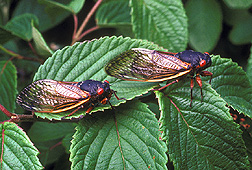This page has been archived and is being provided for reference purposes only. The page is no longer being updated, and therefore, links on the page may be invalid.
|
Read the magazine story to find out more. |
|
|
Fungi Found on Cicadas May Benefit Science
By Luis PonsFebruary 21, 2006
Some cicadas harbor a fungus that has biomedical potential, according to Agricultural Research Service (ARS) and Cornell University scientists in Ithaca, N.Y. They studied Cordyceps heteropoda, a fungus that grows on and infects some species of cicadas.
Plant physiologist Donna Gibson of ARS’ Plant Protection Research Unit (PPRU) and Cornell research associate Stuart Krasnoff found peptides within C. heteropoda that give it antimicrobial and immunosuppressant properties. They also found that the fungus produces myriocin, a compound being investigated by other scientists for potent immunosuppressant activity that could be a key to preventing post-transplant organ rejection in humans.
The peptides are made up of unusual amino acids, one of which causes the peptide to coil into a helical structure, according to Gibson. This, she added, may be useful for engineering molecules, because most drugs and pesticides are modeled after the chemical structures of natural products.
Most Americans likely base their recollection of cicadas on their experience with Brood X of Magicicada septendecimthe. That’s the species that emerges every 17 years, mostly in eastern parts of the nation, to pile atop one another on sidewalks, bump into windows and people, and collect in storm gutters as they emerge for their mating cycle.
The fungus studied here, however, was taken from Cicadetta puer, an annual cicada that appears from October to February in eastern Australia. It had been placed in PPRU’s Collection of Entomopathogenic Fungi in 1985.
Krasnoff and Gibson came across this C. heteropoda isolate during a molecular screening program started six years ago that’s aimed at developing a diverse core collection for identifying novel chemistries.
The recent findings have been described in the Journal of Natural Products.
Read more about this research in the February 2006 issue of Agricultural Research magazine.
ARS is the U.S. Department of Agriculture's chief scientific research agency.

